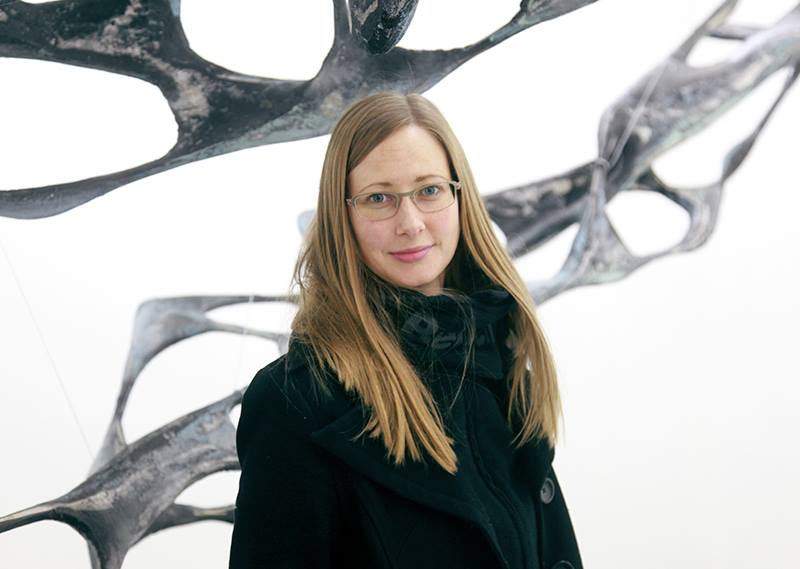empathy
Forget Therapy, Art Is The Key To Inner Peace

“Entering Space” may sound like a wacky 60s sci-fi film, but that does not do justice to the latest exhibition curated by Tina Sauerländer, which explores how our environment can be affected and altered by the art object. Strikingly, the effect is not far from alien, and upon entering the space, I felt like an astronaut discovering new frontiers of art and boundaries of feeling. I met up with Sauerländer during the final stages of crafting the exhibition. For a curator with just days to go before a show and what looked like a lot to do, she was surprisingly calm, composed and full of that excitement which comes from finally realizing a project that began ten months ago. She tells me that "the idea behind the exhibition was to think about how sculpture or even painting can enter and effect the space and to look at how the viewer behaves when entering the same space as the sculpture.”
Acting & Reacting In The Space
Like a kid in a candy store, my body was buzzing and hungry for the art around me. While mystery surrounded the works of Brenna Murphy and Raul Walch whose works were not yet viewable until the opening night (the disadvantage of a sneak preview), the other works were enough to satisfy my curiosity. Philip Hausmeier’s Reichstag-like dome on a foam base titled "Nothing to see, nowhere to be," provides a captivating and almost futuristic vision while Fernanda Trevellin’s piece pumps blue liquid around clear plastic tubes like a scientific experiment – whizzing me back to the chemistry classes I was so bad at in school. Wolfgang Flad’s great swirling structure suspended from the ceiling floats like cosmic molecules – you wouldn’t guess it is made from wood and old art catalogues. Kathrin Köster’s shiny triangle also deceives the eyes as the apparently metal structure (evocative of an alien symbol on the side of the mother ship) is actually made of wood, which for me changes the meaning of the piece entirely. Yet seeing these pieces through the materials with which they were made was my reaction to a playground of experimental art, as I tried to make sense and draw reason out of it.
As we walked and talked around the exhibition space, Sauerländer shares with me that space is “a very emotional and physical thing. When you enter a space, whatever type of space, it creates a feeling in you.” This got me thinking about feeling and what the great Charlie Chaplain once said: “We think too much and feel too little.” At the exhibition, I realized that this is exactly what I was doing. I got lost in my thoughts and forgot to feel the exhibition.
I am constantly in my head with a thousand and one thoughts and questions all fighting and jostling for space: How can I put that into words? What does that remind me of? This naturally got me pondering the question of how I was relating to the space around me. But I soon stopped trying to think about the concept or look of the works and decided to just feel. With the thoughts leaving my crowded head as darkness encroached outside, I began to see – or rather feel – the works more clearly, without trying to categorize or analyze them.
I felt a space full of works into which so much passion and care had been poured into. Two of the artists were still working late on their pieces. The room was loud with the echoes of artist Eliana Heredia perfecting her piece on the wall with sandpaper and the quieter lick of paint as Maria Muñoz added her finishing touches. It felt special to observe the process of creation in a room where all that mattered was the stroke of a paintbrush and the curve of a structure. Hidden in the middle of a bustling Berlin street, in this space I felt absorbed in a therapeutic bubble. I no longer had to try and find an explanation to why I liked certain pieces, because looking at them simply made me feel good. That feeling was reason enough for me.
I asked Eliana Heredia how she feels about the area she has created with sandpaper and plaster. “Silence," she tells me, "It is a silent corner. And I like it. It is a minimal work for me, because normally, I make, ahhh… Big,” gesturing a giant imaginary artwork in the air. It struck me how different her view of her work and the space was to mine. Where Heredia saw silence I was seeing and hearing the loud echoing of her hard work. That’s the issue with feeling and how we relate to our environment and art; it creates the most subjective and often most wonderfully incomprehensible sensation. Art is a thoughtful process, but what it creates in you is feeling.
A panel discussion on the subject of “What makes a sculpture in the 21st century? (Was zeichnet Skulptur im 21. Jahrhundert aus?)” will take place at Kunsthalle m3 tonight, Thursday October 24th, to accompany the exhibition. More information here.
- Kunsthalle m3 – “Entering Space” Group Exhibition – October 20th-30th, 2013 – Wed-Sat: 4-7pm
Article by Frances Cragg
Be the first to write a comment.
Your feedback




